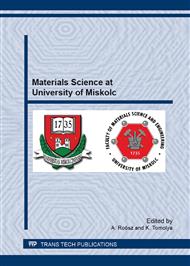p.233
p.241
p.248
p.259
p.268
p.275
p.284
p.294
p.304
The Effect of Micro-Impulse Current on the Morphology of Tin Electrodeposited from Chloride Solutions
Abstract:
A flexible and efficient process of tin electrorefining has been devised, using aqueous solutions of relatively low HCl and tin chloride concentrations. Any additives have been avoided, which enhances purity but also incurs the difficulty of obtaining compact cathode deposits. This feature is however assisted by the natural inhibition in complexing chloride solutions and the modulation of the current. Due to the rough dendritic crystal growth, special provisions are required to avoid short circuiting. Using short pulses in the 50-250 μs range of periodically reversed or interrupted currents, the lengths of the usually large dendrites can be moderated. The periodic current with extremely short cycle times and special electrode arrangement can be utilized for averting short circuits and for achieving better coverage of the cathode surface. This technique can be applied efficiently to obtain pure tin from soldering waste materials.
Info:
Periodical:
Pages:
294-303
Citation:
Online since:
March 2013
Authors:
Price:
Сopyright:
© 2013 Trans Tech Publications Ltd. All Rights Reserved
Share:
Citation:


